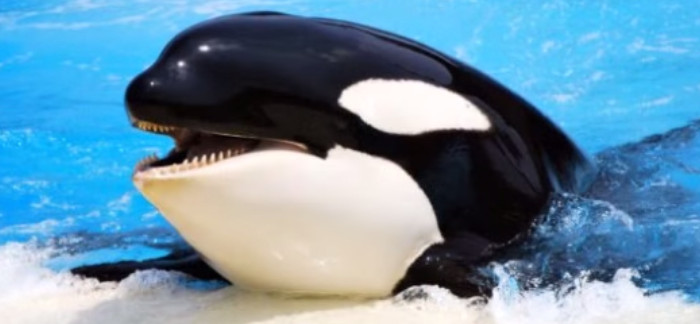Did you know that killer whales aren’t actually whales? They are actually the world’s biggest dolphin. They have a number of special characteristics that make them a truly unique creature. Called Orcas to eliminate the confusion between whale and dolphin, these animals swim in pods and have a strong family bond, especially between mother and child. They thrive in the wild and can swim at speeds of up to 35 miles per hour.
If you have a love for killer whales, then here are some more interesting facts about them so that you can get to know these intelligent creatures a little more.
1. That’s a Lot of Teeth!
Orcas can have up to 56 teeth in their mouth. All of them are interlocking and they can be up to three inches long. The conical shape of their teeth makes them the perfect tool for tearing or ripping food, but not necessarily for chewing food. When killer whales are enjoying their dinner, then tend to just swallow the food whole.
They need to consistently eat to support their metabolism. It takes a lot of work to keep an 11 ton body moving in the ocean’s waters! Killer whales tend to grow to a length of about 19 feet, but some animals that have been observed can be over 30 feet long. That’s the same length it takes in American football to achieve a First Down.
2. They Don’t Live Well in Captivity
Orcas are animals that love the open sea. With their natural pod structure and emphasis on family, you can find them swimming together and occasionally breaching, just like with other dolphins. The problem that killer whales face in captivity is directly related to their size. Holding tanks for them provide a fraction of the space that they are used to having. Killer whales in captivity will also attack each other and be temperamentally different from those in the wild.
Orcas that live out in the wild can live for up to 80 years. The average lifespan of a wild killer whale is about 50 years. For killer whales that are held in captivity in places like SeaWorld, it is a very different story. Their lifespans are cut by 50% on average.
Part of the reason for this might be isolation, but another component is that the natural family structure is often artificially modified while in captivity. Young whales are often taken from their mothers at an early age for training purposes and the animals have show evidence of emotional trauma when this occurs. As with any built up stress, a negative health consequence is often the result.
3. They Are Extremely Stable Animals
The organized pods that the killer whales tend to form out in the waters of the ocean are some of the most stable animal family structures that we have ever observed. This stability translates into a number of unique facts about this animal.
No humans have ever been intentionally attacked by a killer whale that was living in the wild. When they recognize that it is a human that has been targeted, these animals will typically leave the area so that the human can be safe.
Their intelligence is one of the highest ever observed in the animal kingdom and pods have been known to fool human hunting parties through their strategies to keep their calves safe.
They regularly communicate with each other to form their own offensive and defensive movements when looking for food or having an animal attack them.
Much of this stability is attributed to the unique family structure of the pods. There can be three or four generations in a pod, all direct descendants of each other, and all working together to achieve a common good for the family. This creates a natural form of social networking that builds inter-whale relationships that keep the pod together and emotionally satisfied on the whole.
Orcas use a process called “echolocation” to communicate. This is a lot like a radar system that we use to identify objects. The soundwaves bounce off of the objects and the killer whales can then determine what that object is. They even have the ability to identify which type of fish is swimming by them by the echo that the fish makes.
What’s even more fascinating about this communication technique is the fact that scientists have observed different vocal “accents” within the echolocation. You know how someone from the southern United States will sound different vocally from someone who is from London? That’s the same thing that is going on with the different echolocation noises that Orcas can make.
4. The Women Rule the Day
It is the women who are in control of each Orca family pod. Most family units are controlled by the oldest female killer whale and then her calves, dependent older offspring, and potentially older male children continue to remain. Some pods have been known to pick up stray males from time to time as well. It’s easy to tell if you’re looking a girl Orca – her dorsal fin is smaller and curves, while the male dorsal fins is rather triangular and straight.
This is what makes the Orca a unique creature in the animal kingdom. The males almost always stick with their mother throughout their entire life. They might wander off for mating purposes for a few days because all of the girl killer whales in their pod are close relatives, but they always wind up coming back. A male killer whale is estimated to spend 40% of its entire life within one body length of its mother.
As with other animals, killer whales will still go through mating rituals and the males will compete for the privilege of being able to have a calve, but not all of the female Orcas are actually eligible Orcas. There is a unique component to pod life with this animal. They will not mate with another animal that is a close relative. Mates are chosen from those that are the furthest away from direct relations.
After the calves are born, the male whales actually assume the nurturing role. As the female orcas hunt, the males tend to do the calve-sitting that is required.
5. They Are Smart – Incredibly Smart
Why are killer whales so intelligent? Part of the reason might be the overall size of their brain. Scientists have discovered killer whales can have a brain that weighs up to 15 pounds. That’s almost 5 times heavier than your brain and it makes it one of the largest brains on the entire planet today that scientists know about.
This higher level of intelligence allows them to adapt to changing conditions more readily than other creatures. Killer whales don’t migrate like other dolphins tend to do. The pods might swim out together for several hundred miles to find fresh food that tastes better, but they always tend to return home after a time.
This intelligence also makes them a deadly predator out in the open sea. The Great White Shark tends to strike a fear into people, even just with its name, but it isn’t a true Apex predator. Orcas can kill and eat a Great White when working together as a pod. This makes them the true top of the food chain in the world’s oceans today.
That’s probably a good thing – killer whales need a lot to eat. The average Orca will eat enough food to equal about 5% of their total body weight every day. In practical terms, that’s about 500 pounds of food that is required.
Killer whales are one of the world’s most fascinating creatures, so wanting to see them and get to know them is completely understandable. Thanks to facts like these and the work of scientists who love Orcas as much as you do, we can get to know these majestic animals on a personal level without having to keep them in activity. If you want a truly life changing experience, go on a whale watching expedition that includes Orcas and you will have a much better time than seeing a big killer whale in a tiny tank.




